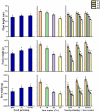Seed Priming with Silicon as a Potential to Increase Salt Stress Tolerance in Lathyrus odoratus
- PMID: 34685950
- PMCID: PMC8539537
- DOI: 10.3390/plants10102140
Seed Priming with Silicon as a Potential to Increase Salt Stress Tolerance in Lathyrus odoratus
Abstract
Water shortage is a major problem limiting the expansion of green areas and landscapes. Using seawater as an alternative source of potable water is not a novel idea, but the issue of salt stress needs to be resolved. Salinity has a negative impact on growth and the aesthetic value of ornamental plants. In order to overcome these challenges, Lathyrus odoratus seeds were hydro-primed and halo-primed with silicon (Si) and silicon nanoparticles (SiNPs), and exposed to seawater levels. Seawater markedly reduced seed germination and growth of Lathyrus seedlings, but halo-priming was shown to significantly alleviate its negative effects. Broadly, SiNPs increased the germination percentage, reduced photosynthetic pigments and carbohydrates decrease, and enhanced water relations, despite having a negative effect on germination speed. Halo-priming significantly increased the proline content and the activities of certain enzymatic (SOD, APX and CAT) and nonenzymatic (phenolic and flavonoids) compounds, that positively influenced oxidative stress (lower MDA and H2O2 accumulation), resulting in seedlings with more salt stress tolerance. Halo-priming with Si or SiNPs enhanced the Si and K+ contents, and K+/Na+ ratio, associated with a reduction in Na+ accumulation. Generally, halo-priming with Si or SiNPs increased Lathyrus seedlings salt stress tolerance, which was confirmed using seawater treatments via improving germination percentage, seedlings growth and activation of the antioxidant machinery, which detoxifies reactive oxygen species (ROS).
Keywords: Lathyrus odoratus; SiNPs; antioxidant; proline; seawater; seed priming.
Conflict of interest statement
The authors declare no conflict of interest.
Figures










References
-
- Al-Gretawee H., Rayburg S., Neave M. The cooling effect of a medium sized park on an urban environment. Int. J. GEOMATE. 2016;11:2541–2546. doi: 10.21660/2016.26.5183. - DOI
-
- WHO (World Health Organization) Urban Green Space Interventions and Health: A Review of Impacts and Effectiveness. World Health Organization Regional Office for Europe; Copenhagen, Denmark: 2017. [(accessed on 15 May 2017)]. Available online: http://www.euro.who.int/__data/assets/pdf_file/0010/337690/FULL-REPORT-f....
-
- Zupancic T., Westmacott C., Bulthuis M. The Impact of Green Space on Heat and Air Pollution in Urban Communities: A Meta-Narrative Systematic Review. David Suzuki Foundation; Vancouver, Canada: 2015.
Grants and funding
LinkOut - more resources
Full Text Sources
Miscellaneous

